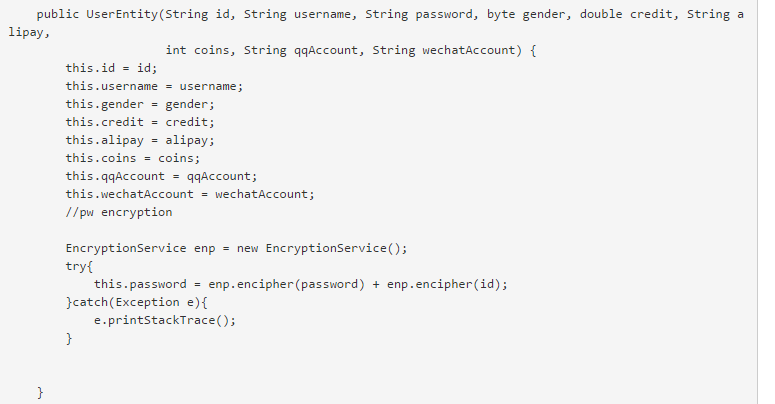Spring 调用Repository的sava方法为什么会调用Entity的set方法?
Spring MVC + Spring Data Jpa + Spring Security + Tomcat,底层封装了hibernate
在我的Entity中有一个User类,User类里有一个密码的字段。
在 密码 的构造函数和set方法里面都对明文密码进行了加密操作。
问题出在我存入的时候。在Controller里面调用构造函数new了一个UserEntity,
然后调用一个Repository类的save方法。经过调试后我发现save方法会再调用我的
set方法,这就相当于在构造函数里加密了一次,又在set里加密了一次。
但是问题是前一阵用Spring-Boot学习也是在构造函数和set里面都对密码进行了加密。
但是并没有出现这样的问题。因此很好奇,求教各位大佬了。
代码贴在下面:
这是UserEntity的代码:
package com.carpool.domain;
import com.carpool.website.service.EncryptionService;
import javax.persistence.*;
import java.io.Serializable;
import java.util.Collection;
/**
* Created by qi on 2016/11/26.
*/
@Entity
@Table
public class UserEntity implements Serializable{
private String id;
private String username;
private String password;
private byte gender;
private double credit;
private String alipay;
private int coins;
private Integer receivedComments;
private Integer carpoolingCount;
private String qqAccount;
private String wechatAccount;
private Collection<ChatRecordEntity> sendedChatRecord;
private Collection<CommentEntity> commentsRecieved;
private Collection<CommentEntity> commentsSended;
private Collection<PaymentRecordEntity> paymentRecievedRecords;
private Collection<PaymentRecordEntity> paymentSendRecords;
private Collection<RoomEntity> ownRoom;
private Collection<RoomEntity> hasPaysRoom;
private Collection<RoomEntity> userParticipateRooms;
public UserEntity() {
}
public UserEntity(String id, String username, String password, byte gender, double credit, String alipay,
int coins, String qqAccount, String wechatAccount) {
this.id = id;
this.username = username;
this.gender = gender;
this.credit = credit;
this.alipay = alipay;
this.coins = coins;
this.qqAccount = qqAccount;
this.wechatAccount = wechatAccount;
//pw encryption
EncryptionService enp = new EncryptionService();
try{
this.password = enp.encipher(password) + enp.encipher(id);
}catch(Exception e){
e.printStackTrace();
}
}
@Id
@Column(name = "id", nullable = false, length = 10, unique = true)
public String getId() {
return id;
}
public void setId(String id) {
this.id = id;
}
@Basic
@Column(name = "username", nullable = false, length = 10)
public String getUsername() {
return username;
}
public void setUsername(String username) {
this.username = username;
}
@Basic
@Column(name = "password", nullable = false, length = 225)
public String getPassword() {
return password;
}
public void setPassword(String password) {
EncryptionService enp = new EncryptionService();
try{
this.password = enp.encipher(password) + enp.encipher(id);
}catch(Exception e){
e.printStackTrace();
}
}
@Basic
@Column(name = "gender", nullable = false)
public byte getGender() {
return gender;
}
public void setGender(byte gender) {
this.gender = gender;
}
@Basic
@Column(name = "credit", nullable = false, precision = 0)
public double getCredit() {
return credit;
}
public void setCredit(double credit) {
this.credit = credit;
}
@Basic
@Column(name = "alipay", nullable = true, length = 20)
public String getAlipay() {
return alipay;
}
public void setAlipay(String alipay) {
this.alipay = alipay;
}
@Basic
@Column(name = "coins", nullable = false)
public int getCoins() {
return coins;
}
public void setCoins(int coins) {
this.coins = coins;
}
@Basic
@Column(name = "QQ_account", nullable = false, length = 20)
public String getQqAccount() {
return qqAccount;
}
public void setQqAccount(String qqAccount) {
this.qqAccount = qqAccount;
}
@Basic
@Column(name = "wechat_account", nullable = false, length = 20)
public String getWechatAccount() {
return wechatAccount;
}
public void setWechatAccount(String wechatAccount) {
this.wechatAccount = wechatAccount;
}
@Override
public boolean equals(Object o) {
if (this == o) return true;
if (o == null || getClass() != o.getClass()) return false;
UserEntity that = (UserEntity) o;
if (gender != that.gender) return false;
if (Double.compare(that.credit, credit) != 0) return false;
if (coins != that.coins) return false;
if (id != null ? !id.equals(that.id) : that.id != null) return false;
if (username != null ? !username.equals(that.username) : that.username != null) return false;
if (password != null ? !password.equals(that.password) : that.password != null) return false;
if (alipay != null ? !alipay.equals(that.alipay) : that.alipay != null) return false;
if (qqAccount != null ? !qqAccount.equals(that.qqAccount) : that.qqAccount != null) return false;
if (wechatAccount != null ? !wechatAccount.equals(that.wechatAccount) : that.wechatAccount != null)
return false;
return true;
}
@Override
public int hashCode() {
int result;
long temp;
result = id != null ? id.hashCode() : 0;
result = 31 * result + (username != null ? username.hashCode() : 0);
result = 31 * result + (password != null ? password.hashCode() : 0);
result = 31 * result + (int) gender;
temp = Double.doubleToLongBits(credit);
result = 31 * result + (int) (temp ^ (temp >>> 32));
result = 31 * result + (alipay != null ? alipay.hashCode() : 0);
result = 31 * result + coins;
result = 31 * result + (qqAccount != null ? qqAccount.hashCode() : 0);
result = 31 * result + (wechatAccount != null ? wechatAccount.hashCode() : 0);
return result;
}
@OneToMany(mappedBy = "sender")
public Collection<ChatRecordEntity> getSendedChatRecord() {
return sendedChatRecord;
}
public void setSendedChatRecord(Collection<ChatRecordEntity> chatrecordsById) {
this.sendedChatRecord = chatrecordsById;
}
@OneToMany(mappedBy = "targetUser")
public Collection<CommentEntity> getCommentsRecieved() {
return commentsRecieved;
}
public void setCommentsRecieved(Collection<CommentEntity> commentsById) {
this.commentsRecieved = commentsById;
}
@OneToMany(mappedBy = "sourceUser")
public Collection<CommentEntity> getCommentsSended()
{
return commentsSended;
}
private void setCommentsSended(Collection<CommentEntity> commentsSended)
{
this.commentsSended = commentsSended;
}
@OneToMany(mappedBy = "targetUser")
public Collection<PaymentRecordEntity> getPaymentRecievedRecords() {
return paymentRecievedRecords;
}
public void setPaymentRecievedRecords(Collection<PaymentRecordEntity> paymentrecordsById) {
this.paymentRecievedRecords = paymentrecordsById;
}
@OneToMany(mappedBy = "sourceUser")
public Collection<PaymentRecordEntity> getPaymentSendRecords() {
return paymentSendRecords;
}
public void setPaymentSendRecords(Collection<PaymentRecordEntity> paymentrecordsById_0) {
this.paymentSendRecords = paymentrecordsById_0;
}
@OneToMany(mappedBy = "host")
public Collection<RoomEntity> getOwnRoom() {
return ownRoom;
}
public void setOwnRoom(Collection<RoomEntity> roomsById) {
this.ownRoom = roomsById;
}
@OneToMany(mappedBy = "payer")
public Collection<RoomEntity> getHasPaysRoom() {
return hasPaysRoom;
}
public void setHasPaysRoom(Collection<RoomEntity> hasPaysRoom) {
this.hasPaysRoom = hasPaysRoom;
}
@ManyToMany
@JoinTable(name = "user_rooms",
joinColumns = {@JoinColumn(name = "uid")},
inverseJoinColumns = {@JoinColumn(name = "rid")})
public Collection<RoomEntity> getUserParticipateRooms() {
return userParticipateRooms;
}
public void setUserParticipateRooms(Collection<RoomEntity> userParticipateRooms) {
this.userParticipateRooms = userParticipateRooms;
}
@Column(nullable = false)
public Integer getReceivedComments() {
return receivedComments;
}
public void setReceivedComments(Integer receivedComments) {
this.receivedComments = receivedComments;
}
@Column
public Integer getCarpoolingCount() {
return carpoolingCount;
}
public void setCarpoolingCount(Integer carpoolingCount) {
this.carpoolingCount = carpoolingCount;
}
}
这是一个测试的TestContrller,主要看insertData方法:
package com.carpool.website.controller;
import com.carpool.domain.UserEntity;
import com.carpool.website.dao.UserEntityRepository;
import com.carpool.website.service.ChatRecordService;
import com.carpool.website.service.UserService;
import org.springframework.beans.factory.annotation.Autowired;
import org.springframework.web.bind.annotation.RequestMapping;
import org.springframework.web.bind.annotation.RestController;
import javax.annotation.Resource;
/**
* Created by qi on 2016/11/26.
*/
@RestController
@RequestMapping("/Test")
public class TestController {
@Autowired
ChatRecordService chatRecordService;
@Autowired
UserService userService;
@RequestMapping("/deleteChatRecord")
String deleteChatRecordTest(){
try{
this.chatRecordService.deleteChatRecordById(10);
return "True";
}catch(Exception e){
return "False";
}
}
@RequestMapping("/insert")
boolean insertData(){
UserEntity userEntity = new UserEntity("12223","asssw","123456", (byte)2793314121856183",12,"123456","123456");
userEntity.setReceivedComments(0);
try{
this.userService.saveStudent(userEntity);
}catch(Exception e){
}
return true;
}
}
实体搞这么复杂不太好吧!
我看了你代码,有些问题,你insertData方法实例化UserEntity对象,然后这个对象里面已经加密过一次密码了,如图所示:
然后你set方法那边又加密了一次密码,如图所示:
所以相当于加密了一次后又再加密了一次。
那个UserEntity的有参构造方法就直接写this.password=password;就行了,还做一次加密操作干嘛?
不知道说得对不对,还是你自己本地断点调试一下吧!说错了,请见谅,还是靠自己!